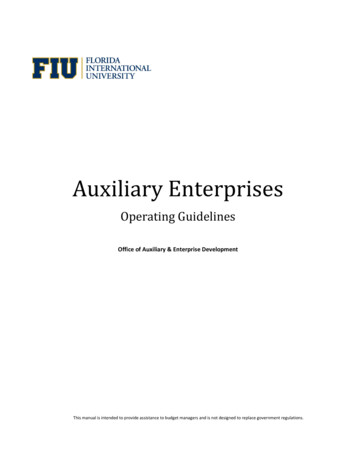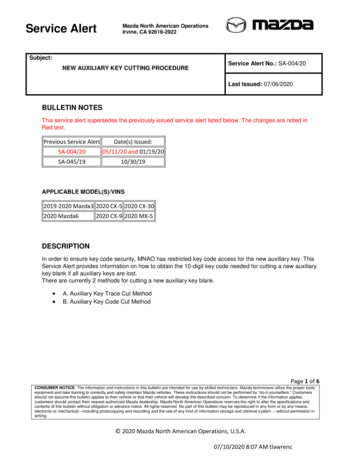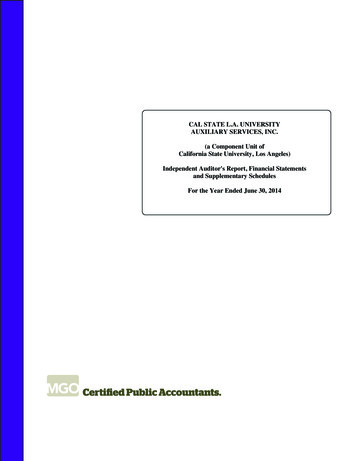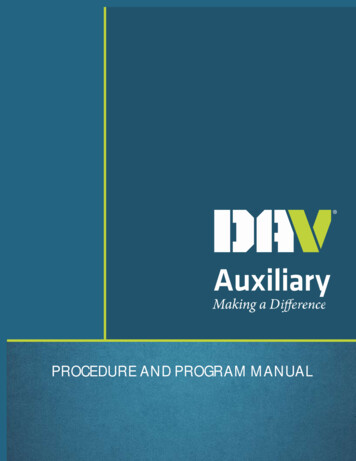
Transcription
Auxiliary EnterprisesOperating GuidelinesOffice of Auxiliary & Enterprise DevelopmentThis manual is intended to provide assistance to budget managers and is not designed to replace government regulations.
Auxiliary EnterprisesOperating Guidelines(Last Updated 2/19/2014)Table of ContentsII.OBJECTIVE AND OVERSIGHT .3III.DEFINITION OF AUXILIARY ENTERPRISE OPERATIONS.3IV.TYPES OF AUXILIARIES.3AUXILIARY OPERATIONS FOR STUDENTS/FACULTY/STAFF .3A.1.Academic Auxiliaries .32.Non- Academic Auxiliaries.4B.AUXILIARY OPERATIONS FOR OTHER THAN STUDENTS/FACULTY/STAFF .5C.RESEARCH RECHARGE OPERATIONS.5D.SELF-SUPPORTING SERVICE ACTIVITIES .5V.ESTABLISHMENT OF AUXILIARY ACTIVITIES .5VI.BUDGETING AND REPORTING.6VII.ACCOUNTING GUIDELINES .7A.RATE AND BILLING GUIDELINES .7B.COMPONENTS OF FEES CHARGED .7C.COMPONENTS OF COSTS .71.Direct Costs .72.Indirect Costs .8Unallowable Costs .83.Other .8D.FUND BALANCE MANAGEMENT .9VIII.OPERATIONS.9IX.DEACTIVATION OF AUXILIARY ACTIVITIES .9APPENDIX A – TYPES OF UNIVERSITY FUNDS .101.Educational and General (E&G) . 102.Contracts and Grants (C&G) . 10Page 1
Auxiliary EnterprisesOperating Guidelines(Last Updated 2/19/2014)3.Agencies . 104.Financial Aid . 10APPENDIX B – REFERENCE SOURCES .111.Laws and Regulations . 115.Research Recharge Center Rate Development. 116.Finance . 117.Record Retention . 118.Other . 11Page 2
Auxiliary EnterprisesOperating Guidelines(Last Updated 2/19/2014)I.Objective and OversightThe purpose of this manual is to define and provide guidelines for establishing and operating AuxiliaryEnterprises, including reporting and accountability requirements at Florida International University.The Office of Auxiliary & Enterprise Development (AED) is responsible for the oversight of auxiliaryoperations to ensure that they promote the University’s strategic mission and best leverage Universityresources. The AED approves the creation and dissolution of auxiliary Activities, ensures compliance withUniversity guidelines and regulatory requirements as determined by federal, state and local laws and aidswith budget development. Also, the AED assists auxiliaries, address operating challenges and identifyopportunities for growth.For further details on services provided by the AED, refer to http://aed.fiu.edu/aboutus.html.II.Definition of Auxiliary Enterprise OperationsAn Auxiliary Operation is an entity that exists to furnish goods or services primarily to benefit students, faculty and staff,and that charges a fee directly related to, although not necessarily equal to, the cost of the goods or services.Auxiliary Operations are managed as self-supporting activities through the fees they charge their customers for products orservices rendered and may not obtain any support from the Educational and General Fund (E&G). At all times, auxiliaryactivities must support the educational endeavor of the University and enhance its functioning.Revenue from other sources, such as gifts and grants, tuition, state subsidies and financial aid are governed by policesspecific to their funding source (refer to Appendix A for a description of additional Funds).III.Types of AuxiliariesAuxiliary operations are categorized by the type of goods and services they provide and the customers that are served.Following is a summary of the types of auxiliary operations at FIU.A.Auxiliary Operations FOR Students/Faculty/Staff1.Academic Auxiliariesa)For-Credit Academic ActivitiesThese activities facilitate and supplement the academic learning experience for studentsreceiving credit towards a degree or certificate program. The revenues in this category representfees charged to students above state-mandated tuition. Examples of such academic auxiliaryactivities at FIU include: Tuition-plus (“value-added”) and self-supporting coursesOnline and distance learning coursesLab access or equipment useStudy abroad programsPage 3
Auxiliary EnterprisesOperating Guidelines(Last Updated 2/19/2014)The funds generated by for-credit academic activities are restricted in that fees charged shouldapproximate costs with reserves generally allowed for working capital needs and future capitaloutlays. Accumulating general reserves to guard against adverse market demand conditions or tofund new auxiliary opportunities are expressly prohibited.b)Non-Credit Academic ActivitiesNon-credit academic auxiliaries provide education without university credit. Examples of suchacademic auxiliary activities include: Conferences & seminarsProfessional education (e.g. review courses, licensure education, non-credit certificates)Vocational trainingCenters and InstitutesThe funds generated by non-credit academic activities are unrestricted in that fees charged maybe used to support other activities at the unit/college level.Additional guidance on pricing and operating academic auxiliaries is available on the AcademicAffairs web page at http://academic.fiu.edu/polman/sec12web.htm.2.Non- Academic Auxiliariesa)Other Fee-Based AuxiliariesOther fee-based activities benefit primarily students, faculty and staff in terms of costs, quality,timeliness or convenience. Examples are: Parking and transportationHousingHealth, student and recreation centersThe funds generated by other fee-based activities are restricted in that fees charged shouldapproximate costs with reserves generally allowed for working capital needs and future capitaloutlays.b)Contractual/ Commission AuxiliaryContractual/commission auxiliaries produce revenue by charging a contractually agreed baserate and/or commission for the rental of space or for providing other services. Examples of theseinclude: Food servicesBookstoreOther retail operations (e.g. salon, dry cleaners)Rates charged are negotiated with the vendor and should not be significantly less than the fairmarket value of similar operations outside the university.Fund balance surpluses may be used to maintain or enhance existing or surrounding facilities.Page 4
Auxiliary EnterprisesOperating Guidelines(Last Updated 2/19/2014)B.Auxiliary Operations for OTHER THAN Students/Faculty/StaffThese enterprises provide services primarily to external parties. They promote the mission of the university byproviding students and/or faculty with opportunities to gain real-life, practical skills to reinforce their educationalexperience or background. These auxiliaries may also generate revenues to the University through sponsorship,promotions and marketing partnerships. Examples are: South Beach Wine and Food FestivalKovens CenterConsulting agreementsCultural eventsThe funds generated by services to external parties are unrestricted in that fees charged may be used to fundother activities at the unit/college level.C.Research Recharge OperationsResearch Recharge Centers are operating units within the University which provide research-related goods andservices primarily to the university’s sponsored programs and incidentally to members of the community for a fee.Examples of some FIU Recharge Centers are: Biology VanAnimal Care VivariumEnvironmental Molecular & Cyto, Stable Isotope LabSERC Nutrient AnalysisResearch Recharge Centers differ from traditional auxiliaries in that they are primarily research-oriented and aretherefore subject to federal regulations which require, among other things, that they operate on a break-evenbasis.Because of the special regulatory environment in which they operate, Research Recharge Centers are reviewedand approved through the Division of Research and are not covered by these Auxiliary Enterprise Guidelines.Guidelines for establishing and operating Research Recharge Centers can be found at research.fiu.edu/.D.Self-Supporting Service ActivitiesThese service activities provide a specific type of service to various University activities and units and aresupported by cost-based charges to the benefiting activities and units. The activities in this category usuallyprovide a service to other activities rather than individuals, although individuals and external users may be servedin limited cases. Examples of Self-Supporting Service Activities include University Copy Centers andTelecommunications (UTS).IV.Establishment of Auxiliary ActivitiesIn establishing an auxiliary enterprise the University is mindful that the need for such goods or servicesexists and, if provided at a reasonable cost and at a convenient location, would enhance and support theUniversity’s instructional, research, or public service programs. The plan to provide these goods orservices through a University-operated or affiliated auxiliary enterprise must also take into account theavailability, the price, and the quality of any such goods or services offered by the local businesscommunity.Page 5
Auxiliary EnterprisesOperating Guidelines(Last Updated 2/19/2014)The Unit requesting a new auxiliary activity number will first submit a pro forma financial package to theAED, which includes: Description of goods/services to be providedUser/customer mixDescription of how the activity promotes the University’s missionSource of start-up capitalProjected 3 year revenues including determination of the rate/price to charge per unitEstimated 3 year direct and indirect expenditures by type including justification of overhead feesRate comparison of similar services charged by outside vendors, if applicableLocation where the activity will take placeWhether the activity already exists on campusGuarantee activity number that can cover any deficit until the activity has earned sufficient revenueApproval of the Operating Manager (Chair, Dean or Director) and Executive Area Budget Manager(EABM).The New Activity pro forma financial package can be found athttp://aed.fiu.edu/downloads/New Activity ProForma Financial Package.xlsxOnce approved, a new activity number will be assigned to the activity. Individual auxiliary activitynumbers will only be established for new auxiliary activities with projected annual revenues greater than 10,000 by the second year of operations. Auxiliary activities with less than 10,000 in projected annualrevenues by the second year of operation can be operated under a Miscellaneous Auxiliary activityestablished under each Unit/College.V.Budgeting and ReportingThe primary responsibility for managing and operating each auxiliary shall rest with the unit’s OperatingManager (or Chair). Each Operating Manager shall work with the unit’s Finance Manager (or Director) todevelop budgets and operating plans and shall monitor the financial health of the unit.Annual operating budgets and forecasts set formal financial goals for each unit and should be consistentwithin the guidelines provided by the Office of Financial Planning (OFP) athttp://finance.fiu.edu/ofp/index.html. Budgets should follow University budget policy and shall accountfor the entire financial operation of the unit. Within the context of the overall operating and capitalbudgeting processes, the Chief Financial Officer through the Office of Auxiliary & Enterprise Developmentis responsible for reviewing and recommending the annual auxiliary budget to the President, which isultimately approved by the Board of Trustees.The Finance Manager (FM) is responsible for ensuring that annual budgets and forecasts are entered inthe University’s financial system in a timely manner. The Executive Area Budget Managers (EABM’s) areresponsible for performing quarterly variance analysis and providing those reports to the AED. Arepresentative of the AED meets with FM’s and/or EABM’s periodically to review the financial results ofthe auxiliaries and also conducts an annual review of any operating changes and plans.FIU’s fiscal year runs from July 1 to June 30 and the budget process from February to June 30th. Forfurther details on entering an online budget, refer to OFP - PantherSoft Budget Manual.Page 6
Auxiliary EnterprisesOperating Guidelines(Last Updated 2/19/2014)VI.Accounting GuidelinesAccounting policies, procedures and manuals can be found on the Office of the Controller webpage athttp://finance.fiu.edu/controller/QL ControllerProceed.html.A.Rate and Billing Guidelines1.Rates established by auxiliaries must be nondiscriminatory; all users/customers are charged the same rate forthe same level of goods or services purchased under similar circumstances.2.The use of special rates, such as for high-volume work or for less demanding applications, is allowed but suchrates must be equally available to all users/customers and communicated as such. Regulations requiresupporting documentation justifying the rate development methodology for special rates.3.All users/customers must be billed for goods and services received at the time of product/service delivery, butno later than the last day of the month in which the product/service is provided.4.Each auxiliary enterprise is considered an individual business. All revenues and expenses associated with theoperation of the auxiliary business shall be assigned to that auxiliary’s specific activity number so that thefinancial performance of that individual enterprise can be determined.B.Components of Fees ChargedFees charged for all individual auxiliary activities must incorporate the reimbursement of costs incurred inproviding the services, including: Cost recovery of direct and indirect costsReasonable working capital needs (normally, up to 60 days)Reserves for expected capital outlay or to service debtFees charged for unrestricted activities can incorporate costs to: Fund new auxiliary opportunities at the unit/college levelFund discretionary E&G activities at the unit/college level (e.g. adjunct salaries, travel, materials and supplies,dues and subscriptions, etc.).Fees charged should not be significantly less than the fair market value of similar operations outside the university.C.Components of CostsEach auxiliary activity shall be accounted for as a self-sustaining enterprise whether the service is operated by theuniversity or by a private contractor under the university’s supervision. As such, all costs incurred by the auxiliaryoperation should be “fully loaded” into the rates charged, thus ensuring that costs required to generate revenuesare matched against the actual revenue earned. These costs include:1.Direct CostsDirect costs are those that can be specifically identified with the execution or direct support of servicedelivery. Execution costs examples include overload salaries of professors teaching tuition-plus courses,materials and supplies used to deliver the service, etc. Direct support costs include salaries ofadministrative personnel, office supplies, property insurance, etc., involved in the operations of theauxiliary.Page 7
Auxiliary EnterprisesOperating Guidelines(Last Updated 2/19/2014)Auxiliary direct costs initially funded by non-auxiliary sources (e.g. by E&G) should be allocated to theauxiliary business within the month they are incurred. Examples include salaries, or portions of salaries, ofE&G-funded faculty contributing to the delivery of auxiliary services, such as conferences/seminars orconsulting projects.2.Indirect CostsIndirect costs are those costs which cannot be specifically identified with the unit of output or service,usually benefitting several activities. Examples of these indirect (shared) costs include salaries and relatedcosts of administrative, finance and marketing personnel supporting entire units/colleges.Units/colleges should allocate these shared costs to individual auxiliaries based on a methodology applieduniformly among all the activities. Examples of such methodologies include percentage of time dedicatedto different activities or as a percentage of revenues. This methodology should be documented and kepton record by the College.In addition, a Shared Services Fee is charged to auxiliaries to address auxiliary use of university-wideresources, such as human resources, accounting, legal, etc. The Shared Services Fee for the 2013-2014fiscal year is 7.0% of total operating expenses (salary, OPS, operating expenses), except for studentActivity & Service fees (A&S) and health fee-related activities for which the rate is at 5.5%.FY 2013-14Auxiliary Operating ExpensesActivity & Services (A&S) Fee OperationsHealth Fee-related OperationsFY 2014-157%7%5.5%5.5%Auxiliary services except for self-supporting academic programs may be housed in buildings that arefinanced from other sources (e.g. E&G).Note: Beginning January 2014, Purchases for Resale will be excluded from the base upon which theShared Service Fee is calculated for those units that pay rent. Units that incorrectly book expenses to thisaccount will be charged the related additional Shared Service Fee expense in subsequent periods.Unallowable CostsAccording to State Regulations and FIU Policy there are certain goods which may not be purchased withauxiliary monies under any circumstances. Refer to the university’s Purchasing Manual chasing%20Manual-Final-Updated%2002-22-10.pdffor details.Note: Unallowable costs for recharge centers are specifically addressed in the Research Recharge Centerpolicy document on the University's Policies page at http://policies.fiu.edu/Individual auxiliaries cannot incur expenses of an unrelated auxiliary, even if they are managed by thesame unit/college.3.OtherThe University is exempt from the federal corporate income tax because of its exempt purposes, i.e., itseducation, research, and public service activities. However, in instances where the University receivesrevenue from activities unrelated to its exempt purposes, the revenue (referred to as Unrelated BusinessPage 8
Auxiliary EnterprisesOperating Guidelines(Last Updated 2/19/2014)Income (UBI)), may be subject to tax. Refer to Tax Policy at http://policies.fiu.edu/files/270.pdf fordefinitions and applicability standards of unrelated activities or contact the Office of the Controller.D.Fund Balance ManagementFund balances for restricted activities will be reviewed during the annual budgeting process by AED, theVP of Business & Finance and the CFO. EABM’s are responsible for providing a plan to use excess fundbalances above those for working capital and expected capital outlay needs to support the operations ofthe auxiliary in the future.Fund balances for unrestricted activities in excess of working capital and expected capital outlay can beused for the benefit of other unit/college operations. The excess balances in individual auxiliary Activitiesshould be transferred at least annually to a Unit/College Discretionary Dean Reserve and can be spent onfunding new initiatives or incidental expenses that would otherwise be paid out of E&G funds (e.g. travel,materials and supplies, dues and subscriptions, etc.). The plan to use these funds will also be reviewedduring the budgeting process.VII.OperationsEvery auxiliary must have written policies and procedures which guide the day-to-day operations of theactivity, document the rate development methodology or other noted information about the activity anddirect its business processes.Auxiliary departmental policies and procedures must be in compliance with University policies andprocedures and those expressed in this manual. Where differences exist, the University’s policies andprocedures shall take precedence.In order to best leverage university resources and share best practices, AED will periodically organize workgroups of auxiliary subject matter experts. Participation in these groups is voluntary but highlyencouraged.VIII.Deactivation of Auxiliary Activities1Auxiliary Department IDs which have been inactive for 12 months are subject to inactivation . Existingbalances (positive or negative) in the inactivated auxiliary Activities must be zeroed-out and should beabsorbed by the unit/college’s reserves. Note: Auxiliary funds can only be transferred to other auxiliarydepartment ID’s and not to E&G department ID’s.In limited situations, the unit may request to re-use an auxiliary department ID. The AED will approve such a request as longas the existing balance of the auxiliary department has been zeroed-out and there are no revenues or expenses in the pastfull fiscal year. This will ensure a clean break in history between one auxiliary activity and another.Auxiliary Activities which cannot control costs sufficiently to be able to establish rates for their goods andservices which are competitive with those offered by the private sector will be reviewed for continuance.1Unit/College reserve department ID’s are exempted from this action.Page 9
Auxiliary EnterprisesOperating Guidelines(Last Updated 2/19/2014)Please refer to the Office of the Controller website for the procedure on inactivating a department ID.APPENDIX A – Types of University FundsWithin the university setting there are various types of funds including: Auxiliary, Educational and General (E&G),Contracts and Grants (C&G), Financial Aid and Agencies. Below is a short comparative description of these funds.1.Educational and General (E&G)This budget entity includes state funds appropriated from general revenue, lottery funds and tuition. Itconsists of the functional categories of Instruction and Research, Administration and General, Library,Plant Operations and Maintenance, Academic Support, and Student Affairs.2.Contracts and Grants (C&G)C&G contains activities in support of research, public service, and training. These activities are fundedfrom awards earned on grants, contracts, or cooperative agreements from federal, state, or localgovernment agencies, as well as from nongovernmental organizations and individuals.3.AgenciesMonies held by an institution acting as custodian or fiscal agent. The funds are deposited with theinstitution for safe keeping, to be used or withdrawn by the depositor at will. These funds may be held onbehalf of students, faculty, staff, organizations, or some other third party.4.Financial AidThe institution is holding the money funded by institutions, private donors, state, and federal acting ascustodian or fiscal agent. Financial Aid provides financial assistance through a scholarship grant programfor students in need of financial support.Specific fund definitions may be found under the “Fund Matrix” section e 10
Auxiliary EnterprisesOperating Guidelines(Last Updated 2/19/2014)APPENDIX B – Reference Sources1.Laws and RegulationsState University System of Florida, Property and Finance; 6C-9.013 Auxiliary OperationsFlorida Statute 1011.47 “Auxiliary enterprises; contracts, grants, and donations”NACUBO Advisory 99-2, “Accounting and Reporting for Auxiliary, Auxiliary-Other and Other Selfsupporting Activities”5.Research Recharge Center Rate Development6.FinanceCarnegie Mellon University - Nondiscriminatory RatesExcess Reserves - University of Maine Public University System – Section III-F Page 3 of 4FIU Cash Control PolicyAuxiliary Cash Transfer Request FormAdditional Budget Authority RequestDivision of Finance websiteFIU Purchasing Policy7.Record RetentionFIU Records Retention Schedule For Sponsored Project DocumentsState of Florida General Records Schedule GS1-SL For state and local government agenciesState of Florida General Records Schedule GS5 For Universities And Community Colleges8.OtherAcademic Affairs Policies, Manuals and HandbooksPage 11
receiving credit towards a degree or certificate program. The revenues in this category represent fees charged to students above state-mandated tuition. Examples of such academic auxiliary . Accounting Guidelines . Accounting policies, procedures and manuals can be found on the . Office of the Controller webpageat










